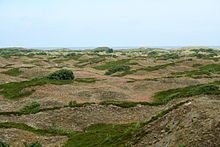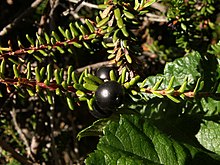Black crowberry
| Black crowberry | ||||||||||||
|---|---|---|---|---|---|---|---|---|---|---|---|---|

Black crowberry ( Empetrum nigrum ) |
||||||||||||
| Systematics | ||||||||||||
|
||||||||||||
| Scientific name | ||||||||||||
| Empetrum nigrum | ||||||||||||
| L. |
The black crowberry ( Empetrum nigrum ) is a species of the crowberries ( Empetrum ) genus . Locations of crowberry are sandy heaths , heathland , bog edges . This species is very rare in the Alps , where it is represented by the hermaphrodite crowberry ( Empetrum hermaphroditum ). The black crowberry is circumpolar. The name crowberry is derived from the digestive spread of crows . The black fruits are edible.
description
The black crowberry ( Empetrum nigrum ) is very similar to the hermaphrodite crowberry ( Empetrum hermaphroditum ).
Vegetative characteristics
The black crowberry is a prostrate, evergreen, carpet-forming dwarf shrub that reaches heights of up to 50 centimeters. The individual shrubs can be over 80 years old.
The needle-like, runny leaves are up to 6 millimeters long and about 2 millimeters wide and are rolled over at the edge of the leaf.
Generative characteristics
The black crowberry is predominantly dioecious, separate sexes ( diocesan ). The color of the rather inconspicuous, unisexual flowers is pale pink in the male and purple in the female.
Berry-like stone fruits are formed.
The black crowberry ( Empetrum nigrum ) has the chromosome number 2n = 26, while the hermaphrodite crowberry ( Empetrum hermaphroditum ) has the number 2n = 52.

Ecology and phenology
The black crowberry is a root creeper . The black crowberry forms a mycorrhiza of the Ericaceae type. Located on the underside of the leaf stomata are only by a narrow gap with the outside air, this probably an adaptation to the mineral salt poverty of the soil is as an adaptation to the dryness.
The flowers are laid out in late summer for the next year. The flowering period extends from May to June. From an ecological point of view, the black crowberry is a nectar-rich "disc flower". Pollinators are bees and hoverflies ; even wind pollination is possible.
Numerous black, berry-like stone fruits grow up until mid-July . These are subject to the digestive spread of, for example, crows .
Occurrence
The black crowberry is circumpolar in the northern hemisphere . In Europe , the distribution area extends from northern to central Europe southwards to the Pyrenees , the central part of the Apennines and Bulgaria.
It thrives best on peaty-sandy soils in extremely humid and mild winter climates . In the Alps, the black crowberry occurs at altitudes of up to 2800 meters in the Bernese Oberland . In the northern Alps , the altitude limit is 2200 meters, while the Zwittrige crowberry in the Allgäu Alps in the Tyrolean part of the Rothornspitze rises to an altitude of 2300 meters. In terms of plant sociology, it thrives above all in societies of the Oxycocco-Sphagnetea, the Genistion pilosi, and in societies of the Empetrion nigri association near the coast.
In Germany, the black crowberry is found in the low mountain ranges Rhön, Eifel, Harz, Thuringian Forest and in the Bavarian Forest. On the North German coast, it populates dunes on the coasts of the North and Baltic Seas. In the lowlands the species is found scattered and often populating in drier places in raised bogs. Occasionally the species can be found in the Harz, in the Thuringian Forest, in the Fichtelgebirge and other peripheral mountains of the Bohemian Basin as well as in the Black Forest.
use
The fruits taste sourly bitter and have a slightly intoxicating and dizzying effect due to their andromedotoxin content .
The fruits are edible raw and cooked. The forms found in Northern Europe with larger and aromatic-tasting berries are consumed in large quantities , especially after frost . The Sami have them frozen in milk as a supply for the winter, the Eskimos eat them as a delicacy mixed with pulpy cod liver , in Iceland they are kept in sour milk or drink the fruit juice and in Greenland they are eaten with seal bacon. In Norway they are used to make wine.
In folk medicine, berries were used against scurvy because of their high vitamin C content and against diarrhea thanks to their tannin content .
Toxicity
The whole plant is not very poisonous; In the Scandinavian countries and northern Russia, the fruits are considered edible raw and processed.
The main active ingredients are: ursolic acid , rutin , quercetin , isoquercetin and ellagic acid ; Andromedotoxin is also found in the plant.
It is likely that there are strong fluctuations in the ingredients of the local races. In extreme cases, honey from Empetrum species can cause gastroenteritis and cardiac complications.
Common names
The other German-speaking common names exist or existed for the black crowberry : Monkey berry ( Pomerania , Silesia ), Apenbär ( Mecklenburg , Brocken ), Apfra, Appenbeere (Mark), Beerenheide ( Lower Saxony ), Besheide (Dutch), rock bush, fulberry, gout herb Ramberry, heatherberry ( Unterweser ), bilberry , shepherdberry ( Graubünden in the Rhine Forest), gooseberry ( East Prussia ), crowberry ( Prussia , Silesia ), bog heather ( Mark ), fog berry ( Pongau ), Rausch ( Austria ), black bogberry bush (Austria), Stone berries, stone heather , Stoanhadach ( Carinthia ), knitted berries, drinking berries, trunks berries ( Ore Mountains ) and gold Wiederthon (Ore Mountains).
literature
- Xaver Finkenzeller, Jürke Grau: Alpine flowers. Recognize and determine (= Steinbach's natural guide ). Mosaik, Munich 2002, ISBN 3-576-11482-3 .
- Manfred A. Fischer, Wolfgang Adler, Karl Oswald: Excursion flora for Austria, Liechtenstein and South Tyrol . 2nd, improved and enlarged edition. State of Upper Austria, Biology Center of the Upper Austrian State Museums, Linz 2005, ISBN 3-85474-140-5 .
- Oskar Sebald, Siegmund Seybold, Georg Philippi (Hrsg.): The fern and flowering plants of Baden-Württemberg . 2nd expanded edition. tape 2 : Special part (Spermatophyta, subclass Dilleniidae): Hypericaceae to Primulaceae . Eugen Ulmer, Stuttgart (Hohenheim) 1993, ISBN 3-8001-3323-7 .
- Ruprecht Düll , Herfried Kutzelnigg : Pocket dictionary of plants in Germany and neighboring countries. The most common Central European species in portrait . 7th, corrected and enlarged edition. Quelle & Meyer, Wiebelsheim 2011, ISBN 978-3-494-01424-1 .
- Lutz Roth , Max Daunderer , Kurt Kormann : Poison Plants - Plant Poisons. Poisonous plants from AZ. Emergency assistance. Occurrence. Effect. Therapy. Allergic and phototoxic reactions . 4th edition. Nikol, Hamburg 2000, ISBN 3-933203-31-7 (reprint from 1994).
- Peter Schütt, Hans Joachim Schuck, Bernd Stimm (eds.): Lexicon of tree and shrub species. The standard work of forest botany. Morphology, pathology, ecology and systematics of important tree and shrub species. Nikol, Hamburg 2007, ISBN 978-3-933203-53-3 (reprint from 1992).
Individual evidence
- ↑ a b Erich Oberdorfer : Plant-sociological excursion flora for Germany and neighboring areas . With the collaboration of Angelika Schwabe and Theo Müller. 8th, heavily revised and expanded edition. Eugen Ulmer, Stuttgart (Hohenheim) 2001, ISBN 3-8001-3131-5 , pp. 728 .
- ↑ Erhard Dörr, Wolfgang Lippert : Flora of the Allgäu and its surroundings. Volume 2, IHW, Eching 2004, ISBN 3-930167-61-1 , p. 310.
- ^ Georg August Pritzel , Carl Jessen : The German folk names of plants. New contribution to the German linguistic treasure. Philipp Cohen, Hannover 1882, page 139. ( online ).
Web links
- Empetrum nigrum L. s. st., common crowberry. In: FloraWeb.de.
- Empetrum nigrum agg., Common crowberry (species group). In: FloraWeb.de.
- Black crowberry . In: BiolFlor, the database of biological-ecological characteristics of the flora of Germany.
- Empetrum nigrum L. s. st. In: Info Flora , the national data and information center for Swiss flora . Retrieved January 13, 2016.
- Distribution in the northern hemisphere.
- Thomas Meyer: Crowberry data sheet with identification key and photos at Flora-de: Flora von Deutschland (old name of the website: Flowers in Swabia ).
- The crowberry - a poisonous plant




